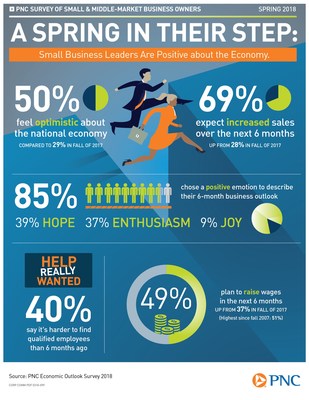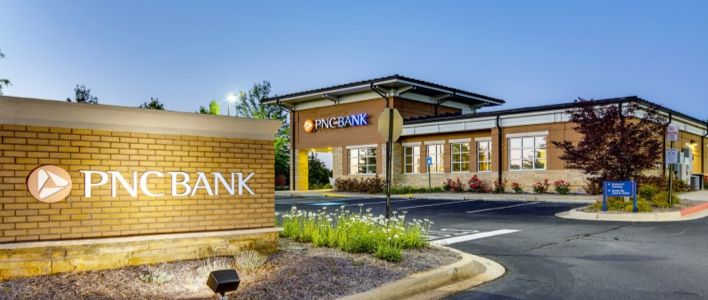PITTSBURGH, April 3, 2018 /PRNewswire/ -- Optimism is running at historic highs in all categories evaluated by The PNC Financial Services Group in the 15-year history of the PNC Economic Outlook, a semiannual telephone survey of small and medium-size business owners and executives. In results released today, exactly half of respondents describe their outlook for the national economy as optimistic in spring 2018, a significant increase compared to the fall 2017 survey (29 percent).

Across-the-board record optimism is reflected by the 85 percent of all respondents who select a positive emotion to describe how they feel about the business climate during the next six months: hope (39 percent), enthusiasm (37 percent) and joy (9 percent). This is a moderate increase from the fall of 2016 (pre-election) when 74 percent of respondents reported positive emotions. The number feeling fear, despair or anger remains in the single digits.
"Small businesses are a key source of economic activity and employment, and owners' perceptions can be a good indicator of what's to come," said Gus Faucher, chief economist of The PNC Financial Services Group, Inc. "The overall findings from our biannual survey, which began in 2003, confirm that the U.S. economic expansion, now almost nine years old and the second-longest in U.S. history, will continue throughout 2018."
In addition, six out of 10 business leaders (61 percent) expect demand for their company's products or services to increase in the next six months, up from 51 percent in fall 2017. While a majority (51 percent) report a good balance between the volume of business and their capacity to handle that volume, 14 percent report having more work than they can handle without adding some capacity.
Key survey findings include:
Wage Watchers—Back in the Fast Lane: Hiring and compensation registered some of the largest increases compared to fall 2017. Wages have remained stuck in the slow lane while the U.S. economy zipped along in the fast lane. Finally, there are signs that wage growth may be accelerating this spring: half (49 percent) of business leaders anticipate increasing their employee compensation in the next six months (compared to 37 percent in fall 2017). This is the highest rate since fall 2007 (51 percent) and good news for the American workforce. In addition, one-third (32 percent) expect to add full-time staff (25 percent in fall 2017) and 25 percent note plans to hire part-time staff, a significant bump compared to 15 percent in fall 2017.
Help (Really) Wanted: Four out of 10 (40 percent) say it is harder to hire qualified employees today compared to six months ago, with the biggest challenge being lack of experience or skill. One-fifth (22 percent) of respondents attribute the lack of hiring to doing more work in other ways like automation, artificial intelligence or outsourcing, representing a significant increase compared to 14 percent in fall 2017.
"With support from tax cuts and an increase in federal spending, U.S. economic growth will accelerate in 2018 and the labor market will continue to tighten," said Faucher. "To prevent the economy from overheating, the Federal Open Market Committee will continue to gradually raise the federal funds rate throughout 2018."
Money (That's What I Want): Nearly seven out of 10 (69 percent) small and mid-size business leaders anticipate increased sales during the next six months, a significant increase from the fall. Two-thirds (64 percent) of respondents expect increased profits, exceeding the prior high (59 percent) set in spring 2005. Most significant is the jump in the number of business leaders who expect to charge their own customers higher prices (41 percent, up from 29 percent in fall 2017), citing increasing business and favorable market conditions as the primary reasons.
A digital package containing national and regional survey results is available at http://pnc.mediaroom.com/digital-packages.
The PNC Financial Services Group, Inc. (NYSE: PNC) is one of the largest diversified financial services institutions in the United States, organized around its customers and communities for strong relationships and local delivery of retail and business banking including a full range of lending products; specialized services for corporations and government entities, including corporate banking, real estate finance and asset-based lending; wealth management and asset management. For information about PNC, visit www.pnc.com.
Methodology
The PNC Economic Outlook survey was conducted by telephone from January 12 to March 6, 2018, among 500 businesses within the United States with annual revenues of $100,000 to $250 million. Sampling error for the national results is +/- 4.4 percent at the 95 percent confidence level. The survey was conducted by Artemis Strategy Group (www.ArtemisSG.com), a communications strategy research firm specializing in brand positioning and policy issues. The firm, headquartered in Washington D.C., provides communications research and consulting to a range of public and private sector clients.
This report was prepared for general information purposes only and is not intended as specific advice or recommendations. Any reliance upon this information is solely and exclusively at your own risk.
CONTACT:
Amy Vargo
(412) 762-1535
amy.vargo@pnc.com
SOURCE PNC Financial Services Group




